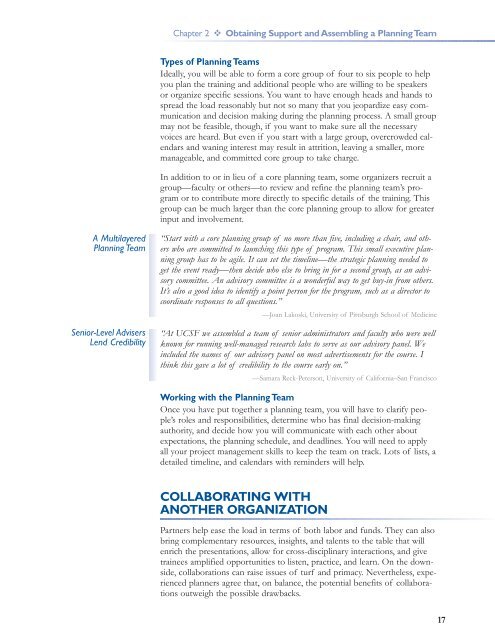Training Scientists to Make the Right Moves - Howard Hughes ...
Training Scientists to Make the Right Moves - Howard Hughes ...
Training Scientists to Make the Right Moves - Howard Hughes ...
You also want an ePaper? Increase the reach of your titles
YUMPU automatically turns print PDFs into web optimized ePapers that Google loves.
Chapter 2 Obtaining Support and Assembling a Planning Team<br />
Types of Planning Teams<br />
Ideally, you will be able <strong>to</strong> form a core group of four <strong>to</strong> six people <strong>to</strong> help<br />
you plan <strong>the</strong> training and additional people who are willing <strong>to</strong> be speakers<br />
or organize specific sessions. You want <strong>to</strong> have enough heads and hands <strong>to</strong><br />
spread <strong>the</strong> load reasonably but not so many that you jeopardize easy communication<br />
and decision making during <strong>the</strong> planning process. A small group<br />
may not be feasible, though, if you want <strong>to</strong> make sure all <strong>the</strong> necessary<br />
voices are heard. But even if you start with a large group, overcrowded calendars<br />
and waning interest may result in attrition, leaving a smaller, more<br />
manageable, and committed core group <strong>to</strong> take charge.<br />
In addition <strong>to</strong> or in lieu of a core planning team, some organizers recruit a<br />
group—faculty or o<strong>the</strong>rs—<strong>to</strong> review and refine <strong>the</strong> planning team’s program<br />
or <strong>to</strong> contribute more directly <strong>to</strong> specific details of <strong>the</strong> training. This<br />
group can be much larger than <strong>the</strong> core planning group <strong>to</strong> allow for greater<br />
input and involvement.<br />
A Multilayered<br />
Planning Team<br />
Senior-Level Advisers<br />
Lend Credibility<br />
“Start with a core planning group of no more than five, including a chair, and o<strong>the</strong>rs<br />
who are committed <strong>to</strong> launching this type of program. This small executive planning<br />
group has <strong>to</strong> be agile. It can set <strong>the</strong> timeline—<strong>the</strong> strategic planning needed <strong>to</strong><br />
get <strong>the</strong> event ready—<strong>the</strong>n decide who else <strong>to</strong> bring in for a second group, as an advisory<br />
committee. An advisory committee is a wonderful way <strong>to</strong> get buy-in from o<strong>the</strong>rs.<br />
It’s also a good idea <strong>to</strong> identify a point person for <strong>the</strong> program, such as a direc<strong>to</strong>r <strong>to</strong><br />
coordinate responses <strong>to</strong> all questions.”<br />
—Joan Lakoski, University of Pittsburgh School of Medicine<br />
“At UCSF we assembled a team of senior administra<strong>to</strong>rs and faculty who were well<br />
known for running well-managed research labs <strong>to</strong> serve as our advisory panel. We<br />
included <strong>the</strong> names of our advisory panel on most advertisements for <strong>the</strong> course. I<br />
think this gave a lot of credibility <strong>to</strong> <strong>the</strong> course early on.”<br />
—Samara Reck-Peterson, University of California–San Francisco<br />
Working with <strong>the</strong> Planning Team<br />
Once you have put <strong>to</strong>ge<strong>the</strong>r a planning team, you will have <strong>to</strong> clarify people’s<br />
roles and responsibilities, determine who has final decision-making<br />
authority, and decide how you will communicate with each o<strong>the</strong>r about<br />
expectations, <strong>the</strong> planning schedule, and deadlines. You will need <strong>to</strong> apply<br />
all your project management skills <strong>to</strong> keep <strong>the</strong> team on track. Lots of lists, a<br />
detailed timeline, and calendars with reminders will help.<br />
COLLABORATING WITH<br />
ANOTHER ORGANIZATION<br />
Partners help ease <strong>the</strong> load in terms of both labor and funds. They can also<br />
bring complementary resources, insights, and talents <strong>to</strong> <strong>the</strong> table that will<br />
enrich <strong>the</strong> presentations, allow for cross-disciplinary interactions, and give<br />
trainees amplified opportunities <strong>to</strong> listen, practice, and learn. On <strong>the</strong> downside,<br />
collaborations can raise issues of turf and primacy. Never<strong>the</strong>less, experienced<br />
planners agree that, on balance, <strong>the</strong> potential benefits of collaborations<br />
outweigh <strong>the</strong> possible drawbacks.<br />
17
















